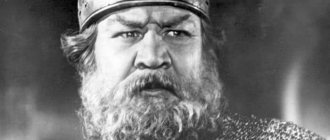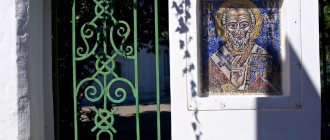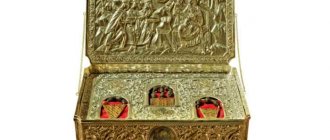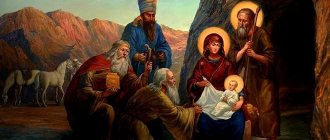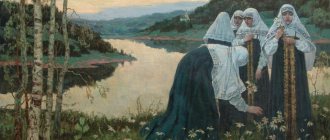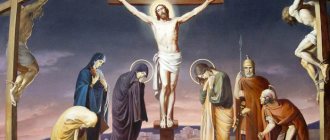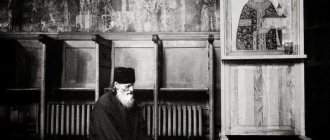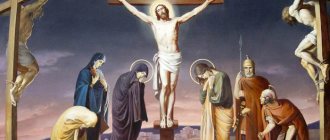Updated July 20, 2022 706 Author: Dmitry Petrov
Hello, dear readers of the KtoNaNovenkogo.ru blog. The problems of preserving cultural heritage are relevant for any nation.
But what if over many centuries concepts change, acquiring completely opposite meanings?
The same concept of sorcery was very honorable at some times, but condemned at others.
So what is the stumbling block? Who are the Magi and why is the attitude towards them so ambiguous?
Protection and support: punishment for encroachment on the weak
Perhaps most consistent with modern ideas are episodes from medieval sources where saints punish people for atrocities against those who are much weaker than the criminal. Descriptions of these cases were frightening even centuries later. For example, in the 19th century, the publisher of the life of Herald of Aurillac (Aurillac) in the Patrologia Latina series did not dare to include the following episode in the printed text - the fragment was published much later.
So, a woman from Limoges visited the tomb of St. Gerald. On the way back, she was raped by a certain horseman. Although any attack on pilgrims was condemned, it was not stopped either by the fact that she was returning from a holy place, or by the very name of Herald. Soon - apparently by the will of the saint - the criminal’s genitals decomposed and fell off. Even after this, he did not repent of what he had done, although the compiler of his life clearly expected this: for a medieval person, such a sudden illness was an understandable sign requiring repentance. However, the sinner did not admit his guilt, so a few days later he drowned in the river, which means he could not repent of his sins even before death - such a fate was feared by any Christian of that era.
This type of punishment from above is quite understandable today. But in this life there are many other examples of frighteningly, from our point of view, cruel punishments, and for much lesser crimes. By the will of the saint, norm-breakers are struck by sudden illnesses, their hands dry up, and the skin peels off their bodies in an instant. Paradoxically, all these facts do not make Herald cruel, from the point of view of the compilers of his life.
On the contrary, they constantly emphasize how gentle a person he was. The saint came from a noble family and could become a warrior, like the generations of his ancestors. Instead, he abandoned secular life and marriage and founded a monastery on his lands, where he later rested. The life mentions that Herald's associates called him timid, shy, almost effeminate. Hagiographers also report that during his entire life in the world he did not inflict a single wound - just as he himself was not wounded, although he participated in battles.
To some extent, these descriptions can be considered a commonplace, characteristic of lives - the saint must be portrayed as kind and meek, not accepting violence. However, these characteristics also partially revealed a specific medieval view of harsh punishments. Herald scholar Matthew Kuefler writes:
“...their cruelty was so built into the structure of the world and was such a common feature of human life that even saints could go on a rampage.”
Among strangers: the cruelty of saints towards Gentiles
Another traditional type of “strike of a saint” is associated with the defense of the interests of Christianity from those of other faiths. Such episodes are present, for example, in the lives of saints who converted other nations to their faith.
Thus, Leonty of Rostov managed to bring the settlement of pagan Merians to Christianity. Arriving in foreign lands, he decided that it was useless to exhort adults whose views had already been formed, and turned exclusively to young pagans. The indignant Merians came to Leonty and his companions, “the Ovi with weapons, and the Druzians with drekoli,” planning, if not to kill the missionary, then at least to drive him out of the city.
In response, the future saint organized a religious procession, and at the sight of him, some of the Gentiles fell dead, and the rest instantly became blind. However, Leonty immediately revived the dead and restored sight to the blind - amazed by his miracles, the Merians voluntarily were baptized.
Not all Christian missionaries were as lucky as Leontius (however, some rare versions of his life report that he was later killed by pagans). More often than not, clerics traveling to foreign lands became victims of local residents who did not want to renounce their faith. The images of saints who were able to lay a crowd of foreigners dead and then revive them showed both the strength of the Christian faith and the almost unbearable difficulties that awaited those who went to distant lands on a spiritual mission.
For sleeping and drunkenness: punishment for disrespect
Another type of situation where saints could show a harsh disposition was when a person treated them with disrespect. Then the saints took rather harsh measures to point out the mistake to the insolent people, and at the same time to those around them. The Lives do not skimp on terrible details in order to impress the reader and instill in him awe of the image of the saint.
Studying the sources, one can notice how broadly their compilers understood disrespect for saints. For example, we find a characteristic episode in the same life of Leonty of Rostov: these events occurred many years after his death, when Leonty had already been canonized. Once on the day of his memory, a miracle happened - at night the saint rose from the tomb, the church where he rested was filled with fragrance, and angelic singing sounded in it. By morning, the candle at the tomb, lit by the angels, continued to burn. After the service, one of the church ministers wanted to extinguish it and was immediately punished: he became deaf and numb, his arms and legs stopped moving. The cleric recovered only after he repented of all his sins.
However, the saints did not always send illness for disrespect; sometimes it was enough to ignore the person’s requests. This was the fate that awaited the lame boy who visited the tomb of St. Thomas Becket in the hope of being healed. To turn to the saint, the young man had to lie down on the slab covering the tomb - this was the traditional method of healing at the saint’s grave. Alas, lying on the stove, the tired boy soon fell asleep. Thomas Becket appeared to him in a dream, cursed the sick man for his insolence, and then declared that he refused to grant him health.
The saints punished Christians not only for disrespect for them personally, but also for violating the rules established by the church. For example, the life of Martin of Tours tells about a woman who, contrary to the ban, worked on Sunday. Her hand became numb, and her fingers did not leave her palm until the offender came to church and vowed never to work on the holy day again.
Believers could also suffer for their careless attitude towards church holidays. Such a case is described in the Volokolamsk Patericon, a collection of stories about the servants of the Joseph-Volokolamsk Assumption Monastery. One day a company of lay neighbors gathered to properly celebrate the day of the apostles Peter and Paul. The friends brewed mead, and one of them came up with the idea to start celebrating even before the church service. Having drunk quite a bit, he saw a man with a black beard and a noticeable bald spot, “with a terrible look.” The stranger hit the mead maker on the cheek so hard that five of his teeth fell out and the drunkard “lay like dead” for a long time, almost completely paralyzed.
Having barely come to his senses, he told his loved ones about what had happened, and they, based on the description of the terrible man, guessed that it was the Apostle Paul himself - he is usually depicted as bearded and almost bald. The unfortunate drunkard never recovered, and his relatives took him to a monastery, where he died a year later.
Literature
- ActaSS. Ian. T. 8. P. 323, 664;
- BHG, N 802–806b; BHL, N 5135-5138;
- NikТdhmoj. Sunaxarist"j. T. 4. S. 405-409;
- MartRom. P. 1, 8;
- JSV. Dec. pp. 704-715;
- Tarragona anonymous “About the city of Constantinople”: Lat. description of relics of the 11th century. // Relics in the art and culture of the Eastern Christian world. M., 2000.
- Tsarevsky A. S. Magi from the East and the Star of Bethlehem. K., 1891;
- Mityakin A.P. Magi from the East: Historical and exegetical essay // Kh. 1893. Part 1. pp. 13-37;
- Protopopov P. Magi of Egypt, Babylon and Bethlehem // ViR. 1901. T. 1. Part 2. P. 755-782, 801-818;
- Fiveysky M., priest. Gospel of Matthew // Lopukhin. Explanatory Bible. St. Petersburg, 1911. T. 8. P. 00-00;
- Kehrer H. “Die Heiligen Drei Könige” in der Legende und in der deutschen bildenden Kunst bis A. Durer. Strassburg, 1904;
- idem. "Die Heiligen drei Könige" in Literatur und Kunst. 2 Bde. Lpz., 1908-1909;
- Hildesheim, 1962;
- Skaballanovich M. About the star of the Magi. K., 1912;
- Knabenbauer J. Commentarius in Evangelium secundum Matthaeum. 2 Bde. 19223;
- Meisen K. Die heiligen drei Könige und ihr Festtag im volkstümlichen Glauben und Brauch. Köln, 1949;
- Olschki L. The Wise Men of the East in Oriental Tradition // Semitic and Oriental Studies. 1951. Vol. 11. P. 375–395;
- Monneret de Villard U. Le leggende orientali sui Magi Evangelici. Vat., 1952;
- Gordini GD Magi // BiblSS. Vol. 8. Col. 494-520;
- Leclercq H. Mages // DACL. T. 10. P. 980-1067;
- Riedinger U. Die Heilige Schrift im Kampf der griechischen Kirche gegen die Astrologie: von Origenes bis Johannes von Damaskos. Innsbruck, 1956;
- Montefiore H. Josephus and the NT // NT. 1960. Vol. 4. P. 139-160;
- Die Heiligen Drei Könige: heilsgeschichtlich, kunsthistorisch; das religionse Brauchtum / Hrsg. A. Wienand. Köln, 1974;
- Schulze A. Zur Geschichte der Auslegung von Mt 2, 1-12 // ThZ. 1975. Bd. 31. S. 150-160;
- Ferrari-d'Ochieppo K. Der Stern der Weisen. Wien, 1972;
- Hughes D. The Star of Bethlehem Mystery. L., 1979;
- Yamauchi EM The Episode of the Magi // Chronos, Kairos, Christos / Ed. J. Vardaman, E. M. Yamauchi. Winona Lake, 1989, pp. 15-39;
- Stramare T. Matteo 2,1–12: Gesù adorato dai magi a Betlemme (Parte I) // Bibbia e oriente. 1997. T. 39. P. 155-167;
- idem. Matteo 2,1–12: Gesù adorato dai Magi a Betlemme (v. 6) e tu, Betlemme, terra di Giuda // Ibid. 1998. T. 40. N. 2. P. 119-125;
- Forster H. Die Feier der Geburt Christi in der Alten Kirche: Beitr. z. Erforschung d. Anfänge d. Epiphanie-u. Weihnachtsfests. Tüb., 2000;
- Maalouf TT Were the Magi from Persia or Arabia? // Bibliotheca sacra. 2001. Vol. 156. P. 423-442.
To a foreign monastery: saints in the struggle for land and property
Another area that the saints did their best to protect was the property of the church, and in particular the monasteries. A striking example is “The Tale of the Life of Mikhail Klopsky,” compiled in the second half of the 15th century on the basis of earlier legends. Mikhail, a relative of Dmitry Donskoy, took upon himself the feat of foolishness, renounced his high position and became a monk of a monastery near Novgorod. Even during his lifetime, he had the ability to cause a variety of ailments in his opponents, and the reason for this was mainly economic conflicts.
It happened like this: having learned about the offense, he “predicted” a certain misfortune for the rule-breaker - and it was immediately brought to life. Most often, Mikhail's opponents were overcome by paralysis. This happened with the Novgorod mayor Grigory Kirillovich, who forbade the monks to fish in the nearest river, since it flowed through his lands. He threatened to break the arms and legs of those who did not obey, but, according to Mikhail, the limbs were taken from Gregory himself. The mayor’s health returned only a year later, when Mikhail allowed him to serve in the Klopsky monastery. In addition, the holy fool was subject to heart disease, dumbness, and memory loss.
Judging by the text of the Tale, the severity of the punishment did not depend on the scale of the crime. The only thing that unites all the victims is that they tried to encroach on the property of the Klop Monastery and the church as a whole. The social status of the attackers did not matter either: simple robbers who entered the monastery with weapons, the priest-thief, the Novgorod boyars who laid claim to church lands, and even the Novgorod archbishop who imposed a “tax” on the monks, that is, wanted to receive money from them.
Historian Alexander Medved notes:
“A modern reader of the life may get the feeling that Mikhail Klopsky did not always act on behalf of God - too often he used his gift of suggestion when resolving rather ordinary, as they would say today, disputes between “economic entities.”
Nevertheless, the compiler of the life clearly believed that the highest justice was on the side of Michael. As soon as the mayor has barely come to his senses, the future saint says: “God will punish the one who starts the army!” - and the scribe clearly agrees with him.
There are similar episodes in Western European lives. For example, the already mentioned Herald of Avrilak, who also came from an influential family, had to defend the monastery from his own nephew. He, together with his people, decided to rob the monastery located on his uncle’s lands. Saint Gerald appeared to the wicked man in a dream, hit him on the head and threatened him with immediate death if he did not leave the monks alone. Later, several more people encroached on the monastery property, and they all died under terrible circumstances: say, the skin of a boy who stole an altar cover from a church was completely peeled off.
Matthew Kuefler, who studied the life of the Herald, believes that there is something more behind specific property disputes, even ordinary ones. He writes that these episodes reflect the turbulent situation that surrounded the monasteries in the Middle Ages. Their lands and property were the object of constant “hunting” both from the nobility and from commoner robbers. It is not surprising that the monks had to defend themselves. The strength of earthly patrons was not always enough, and the reputation of a merciless saint, ready to stand up for his monastery, came to the rescue.
The meaning and significance of gifts from the Magi
Most experts who have studied early Christian literature insist on the version of the three wise men , focusing on three different ages of man, three main races and three gifts brought, which were:
- incense is a symbol of recognition of the baby as a god;
- gold is a symbol of recognition of Jesus as king;
- myrrh (myrrh) - a symbol of the recognition of Christ as a man who, being mortal, will someday be buried.
The essence and symbolism of these gifts certainly emphasizes the significance of the newborn Messiah for the whole world, if even in infancy the great learned men saw in him greatness, holiness and future glory.
As for the Magi themselves, in numerous interpretations of biblical texts the following features are attributed :
- Kaspar (Gaspar) is a young Assyrian king who has not even grown a beard yet;
- Belshazzar (Balthazar) is a dark-skinned man in the prime of life, the king of one of the African countries;
- Melchior is the ruler of Arabia, a gray-haired old man with a long beard (in accordance with Arab traditions).
It is noteworthy that this kind of detail became widespread only in the 4th century, when the apocryphal treatise of the Apostle Thomas “The Gospel of Childhood” was published. True, according to the Gospel of Thomas, Gaspar ruled the Arab people, Melchior ruled the Persian people, and Balthasar ruled the Indian people.
Unlike the texts of the main evangelists (Luke, Matthew, Thomas), more details are contained in the works of the great saint John Chrysostom.
According to the Archbishop of Constantinople, the worship of the Magi symbolized the openness of Christianity even to pagans who were ready to reject previous errors.
And this is understandable: the coming of Christ destroyed the old order and promised a renewal of the outdated way of life. And since the Jews refused to listen to their own prophets, messengers were called from other lands to admonish the people of Israel through them.
